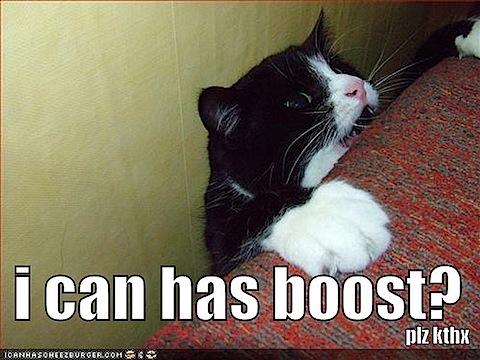For some time now, I’ve been trying to identify the thread that ties together all the different topics I write about here on AuthenticOrganizations. Other than the fact that they interest me, what is the underlying theme that links topics as different as:
After hashing it out with colleagues (thanks to to Cali, Deb, Whitney, and Anne) the link seems to be emerging.
All of these topics have to do with ‘building positive capacity’ in individuals, organizations, and economic networks. They all have to do with building a ‘boost’ into some part of the individual/organizational/community economy. These topics also have a lot to do with the idea of co-creating value– value that exists within and because of the quality of relationships we create with each other.
The Boost Economy (tm)?
For the next several months, I’m going to investigate “The Boost Economy”, at the individual level, the organizational level, and business network level. I’ll test to see whether the idea of crafting your business or your career or your network as something that provides as boost to others as well as to you is in fact something that holds these topics together.
Here’s a rough first draft of a definition:
Defining the Boost Economy
The Boost Economy is a market orientation, a way of thinking about business, a type of network structure, and a principled set of behaviors, all of which connect your local activity to a network of larger benefits for yourself and others.
A boost economy is a way of constructing relationships within your organization to coax out and support what other people have to offer. It’s a way of organizing your business platform so that you make money by helping other people make money, while helping both of you make a difference in the world as a result.
It’s all about figuring out how the work you do can boost the work of others, for overall benefit.
The Mindset of the Boost Economy
The mindset of the Boost Economy is that the work that we do locally (ourselves, in our teams, in our businesses) can do more than benefit us. We can choose to structure and direct this work so that it benefits others. This means that we partner with firms or individuals becuase we share and want to promote the same purpose (e.g., sustainability), or because we share a set of work principles (e.g., Agile, lean startup).
The benefits that our work creates for others have to be more than economic — because the boost is about more than money. There is a mission behind the market, a purpose extending past the platform.
The Structure of the Boost Economy

The Boost Economy is structured so that value builds not just horizontally, as in a ‘value chain’, but also vertically, with recursive value loops that layer one on top of the other and enfold themselves in each other.
As in communities of commerce, one organization structures its business so that they not only build their their clients’ businesses but also so that their clients’ success throws additional value back to the organization.
It’s kind of like a pyramid scheme, but without the swindling and without leaving anyone empty handed.
Thick value, both vertical and horizontal, is just one outcome of the way a boost economy is structured. Another outcome is “increased capacity”.
Boost economies contribute to the growth and development of each element in the system (e.g., individuals, teams, organizations, client groups) so that each is more able to do whatever it does more effectively, as a result of being part of the system.
For example, when an organization like Etsy provides free workshops on marketing to its member sellers, each of those sellers becomes more capable and more effective at marketing, leading to increased sales (and profits for Etsy), to increased competence and maybe even increased business vision for the seller.
Communities of Commerce are great examples of a boost economy. Accelerators and coworking spaces are organizational forms that create bite-sized boost economies.
Communities of economic purpose, the networks of relationships that social enterprises build around themselves and their work, fuel triple-bottom line growth. For example, the PipelineFellowship organizes a set of diverse agents, including mentors, entrepreneurs, and angel investors, around a common goal that has a direct economic inpact (invest/build and make money) makes measurable progress towards a purpose (create social enterprises, empower women investors).
As I look at different organizational forms (e,g., accelerators), specific firms (e,g., Skillshare, Etsy), various business trends (coworking, micro-lending), technologies (social recognition, collaborative works systems) and business philosophies (Humanizing, Lean Startup, Open Innovation) I’ll be asking if and how any of these elements helps to create a boost for individual members and communities/markets.
If you have ideas about other trends to consider, or specific businesses or initiatives I should look into, shoot me an email!
Images from Flickr:
Boost ![]()
![]()
![]() Some rights reserved by hijuka
Some rights reserved by hijuka
Lolcat ![]() Some rights reserved by insertnamehere.99999
Some rights reserved by insertnamehere.99999
 I am an organizational consultant, change advocate, and organizational identity/reputation scholar with a PhD in leadership & organizations. I research, write about, and consult with organizations on the relationships between organizational identity, actions, and purpose. I teach Technology Management, part-time, at Stevens Institute of Technology.
My current research focuses on how social technologies in the workplace can drive organizational change, generate meaning, and catalyze purpose. See the
I am an organizational consultant, change advocate, and organizational identity/reputation scholar with a PhD in leadership & organizations. I research, write about, and consult with organizations on the relationships between organizational identity, actions, and purpose. I teach Technology Management, part-time, at Stevens Institute of Technology.
My current research focuses on how social technologies in the workplace can drive organizational change, generate meaning, and catalyze purpose. See the 
{ 4 comments }
Does this count as a boost? I receive a request to coach a client for increased “presence”. Including input from two experts will multiply benefits to the client. So I contact said experts and ask if they would like to be involved in reviewing the clients “presence” via video tape. Their input will be considered in specifying the goals the client and I work on. The two experts are engaged, paid, and the client benefits from 6 eyes and ears, all focused on helping her improve.
I love this concept, CV!
The volunteer work I do as a PTA member is definitely designed to boost the quality of education students receive, and also — less well known, but the real strength of the PTA — to boost the capacity of parents to become effective leaders and advocates in their communities. Every new PTA officer has access to training and mentoring from the PTA council, district, state, and national organizations. Each time I move into a new role, those PTA mentors give me a boost so that I can accomplish things I have never done before. Each time I move out of a role, I mentor my successor as he or she takes over my responsibilities and grows his or her own capacity to accomplish great things for children and families in our community. All the while, we are setting the example for our children about how to be active and engaged community members. They learn to give their peers a boost too.
I also see the boost economy at work in some school programs like
– Junior Achievement
– DECA (Distributive Education Clubs of America)
– Destination Imagination
– Science Olympiad
All these programs involve community volunteers who work with interested students and encourage them to gain skills in creative marketing, business planning, and scientific and technical skills. Volunteers are often employed by organizations that encourage their staff to volunteer in schools, as a way of investing in the next generation of citizens and skilled workers.
When we pass along our skills to youth, we encourage them to think entrepreneurially, and we give them a boost as they transition from the world of school to the world of work.
I love this idea as well CV, particularly as it is such a useful way to talk about positive contributions, and in the negative, what does not sustain community, for example “vulture capitalism.”
Hmm….if boost economy is a positive economy I was thinking that the opposite might be a drain economy or a drag economy.
Comments on this entry are closed.